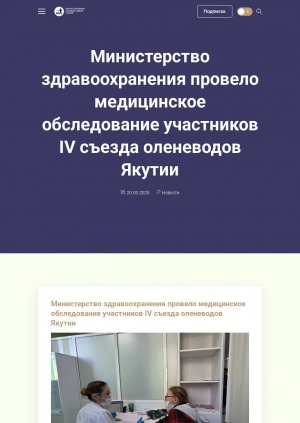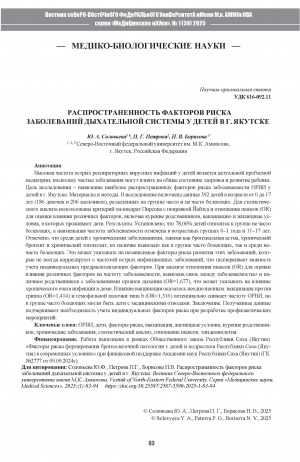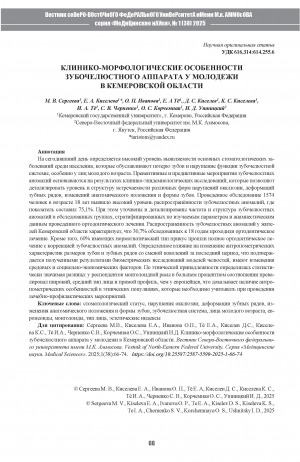Издательство: БИОМЕДГИИС
Год выпуска: 1935
Количество страниц: 32 с.
Год выпуска: 2025
Год выпуска: 2024
Год выпуска: 2025
Год выпуска: 2024
Год выпуска: 2021
Год выпуска: 2020
Год выпуска: 2022
Количество страниц: 12 с.
High incidence of acute respiratory viral infections in children is a pressing issue in pediatrics, since frequent illnesses can affect the overall health and development of the child. The aim of the study was to identify the most common risk factors for acute respiratory viral infections in children in Yakutsk. Materials and methods. The study included data from 392 children aged 0 to 17 years (186 girls and 206 boys), divided into groups of frequently and infrequently ill. For statistical analysis, the Pearson chi-square test with Yates’ correction and the odds ratio (OR) were used to assess the influence of various factors, including smoking of relatives, vaccination, and living conditions in which children live. Results. It was found that 78.06% of children belong to the group of infrequently ill children, and the lowest incidence rate was noted in the age groups of 0-1 year and 11-17 years. It was noted that among children with chronic diseases, such as bronchial asthma, chronic bronchitis and chronic tonsillitis, their presence was detected both in the group of frequently ill and infrequently ill. This may indicate independent risk factors for the development of these diseases, which do not always correlate with thefrequency of acute infectious diseases, which emphasizes the importance of taking into account individual predisposing factors. When analyzing the odds ratio (OR) to assess the impact of various factors on the incidence rate, a relationship was found between the incidence and the presence of relatives with respiratory diseases (OR = 1.677), which may indicate the influence of a chronic source of infection in the home. The effect of vaccination was ambiguous: vaccination against influenza (OR = 1.414) and Haemophilus influenzae type b (OR = 1.316) potentially reduces the incidence of acute respiratory viral infections, but the group of frequently ill children could have children with medical exemptions. Conclusion: The data obtained emphasize the need to take into account individual risk factors when developing preventive measures.
Соловьева, Ю. А. Распространенность факторов риска заболеваний дыхательной системы у детей в г. Якутске / Ю. А. Соловьева, П. Г. Петрова, Н. В. Борисова ; Северо-Восточный федеральный университет им. М.К. Аммосова, Медицинский институт // Вестник Северо-Восточного федерального университета им. М. К. Аммосова. Серия "Медицинские науки". - 2025. - N 1 (38). - C. 83-94. - DOI: 10.25587/2587-5590-2025-1-83-94
DOI: 10.25587/2587-5590-2025-1-83-94
Количество страниц: 9 с.
- Прикладные науки. Медицина. Ветеринария. Техника. Сельское хозяйство > Медицина > Гигиена. Санитария,
- Прикладные науки. Медицина. Ветеринария. Техника. Сельское хозяйство > Медицина > Патология. Клиническая медицина > Стоматология,
- НАУКА ЯКУТИИ > ПРИКЛАДНЫЕ НАУКИ. МЕДИЦИНА. ТЕХНИКА. СЕЛЬСКОЕ ХОЗЯЙСТВО > Медицина > Патология. Клиническая медицина > Стоматология,
- НАУКА ЯКУТИИ > ПРИКЛАДНЫЕ НАУКИ. МЕДИЦИНА. ТЕХНИКА. СЕЛЬСКОЕ ХОЗЯЙСТВО > Медицина > Гигиена. Санитария.
To date, a high level of detecting major dental diseases among the population is determined, which results in tooth loss and impaired function of the dental system, especially in young people. At the same time, preventive and predictive measures of dental anomalies are based on the results of clinical and epidemiological studies, which make it possible to clarify and detail the level and structure of occurrence of various forms of occlusion disorders, deformations of dentition, changes in the anatomical position and shape of teeth. The conducted examination of 1,574 people aged 18 years revealed a high prevalence of dentoalveolar anomalies, where the indicator was 75.1%.At the same time, the frequency and structure of dentoalveolar anomalies in the examined groups, stratified by the studied parameters and anamnestic data of the orthodontic treatment, were clarified and detailed. The prevalence of dentoalveolar anomalies in residents of the Kemerovo region is characterized by the fact that 30.7% of those examined by the age of 18 underwent orthodontic treatment. In addition, 60% of those with a normognathic bite type underwent complete orthodontic treatment with correction of dentoalveolar anomalies. A certain influence on the change in anthropometric characteristics of the size of teeth and dental arches with the change of generations over the recent period, which is confirmed by the results of biometric studies of jaw models, is exerted by changes in environmental and socio-economic factors. At the same time, by ethnicity, a statistically significant difference was determined: most Mongoloid race had a wide, average face type and a straight profile compared to Caucasians, which proves the existence of anthropometric features in different ethnic groups that must be taken into account when carrying out therapeutic and preventive measures.
Клинико-морфологические особенности зубочелюстного аппарата у молодежи в Кемеровской области / М. В. Сергеева, Е. А. Киселева, О. П. Иванова [и др.] ; Кемеровский государственный университет, Северо-Восточный федеральный университет им. М. К. Аммосова, Медицинский институт // Вестник Северо-Восточного федерального университета им. М. К. Аммосова. Серия "Медицинские науки". - 2025. - N 1 (38). - C. 66-74. - DOI: 10.25587/2587-5590-2025-1-66-74
DOI: 10.25587/2587-5590-2025-1-66-74









